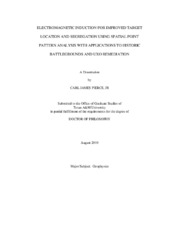| dc.contributor.advisor | Everett, Mark E. | |
| dc.creator | Pierce, Carl J. | |
| dc.date.accessioned | 2010-10-12T22:31:50Z | |
| dc.date.accessioned | 2010-10-14T16:07:42Z | |
| dc.date.available | 2010-10-12T22:31:50Z | |
| dc.date.available | 2010-10-14T16:07:42Z | |
| dc.date.created | 2010-08 | |
| dc.date.issued | 2010-10-12 | |
| dc.date.submitted | August 2010 | |
| dc.identifier.uri | https://hdl.handle.net/1969.1/ETD-TAMU-2010-08-8331 | |
| dc.description.abstract | Remediation of unexploded ordnance (UXO) and prioritization of excavation procedures for archaeological artifacts using electromagnetic (EM) induction are studied in this dissertation. Lowering of the false alarm rates that require excavation and artifact excavation prioritization can reduce the costs associated with unnecessary procedures.
Data were taken over 5 areas at the San Jacinto Battleground near Houston, Texas, using an EM-63 metal detection instrument. The areas were selected using the archaeological concepts of cultural and natural formation processes applied to what is thought to be areas that were involved in the 1836 Battle of San Jacinto.
Innovative use of a Statistical Point Pattern Analysis (PPA) is employed to identify clustering of EM anomalies. The K-function uses point {x,y} data to look for possible clusters in relation to other points in the data set. The clusters once identified using K-function will be further examined for classification and prioritization using the Weighted K-function. The Weighted K-function uses a third variable such as millivolt values or time decay to aid in segregation and prioritization of anomalies present.
Once the anomalies of interest are identified, their locations are determined using the Gi-Statistics Technique. The Gi*-Statistic uses the individual Cartesian{x, y} points as origin locations to establish a range of distances to other cluster points in the data set. The segregation and location of anomalies supplied by this analysis will have several benefits. Prioritization of excavations will narrow down what areas should be excavated first. Anomalies of interest can be located to guide excavation procedures within the areas surveyed.
Knowing what anomalies are of greater importance than others will help to lower false alarm rates for UXO remediation or for archaeological artifact selection. Knowing significant anomaly location will reduce the number of excavations which will subsequently save time and money. The procedures and analyses presented here are an interdisciplinary compilation of geophysics, archaeology and statistical analysis brought together for the first time to examine problems associated with UXO remediation as well as archaeological artifact selection at historic battlegrounds using electromagnetic data. | en |
| dc.format.mimetype | application/pdf | |
| dc.language.iso | en_US | |
| dc.subject | electromagnetic induction | en |
| dc.subject | spatial point pattern analysis | en |
| dc.subject | archaeological geophysics | en |
| dc.subject | UXO | en |
| dc.subject | historic battlegrounds | en |
| dc.title | Electromagnetic Induction for Improved Target Location and Segregation Using Spatial Point Pattern Analysis with Applications to Historic Battlegrounds and UXO Remediation | en |
| dc.type | Book | en |
| dc.type | Thesis | en |
| thesis.degree.department | Geology and Geophysics | en |
| thesis.degree.discipline | Geophysics | en |
| thesis.degree.grantor | Texas A&M University | en |
| thesis.degree.name | Doctor of Philosophy | en |
| thesis.degree.level | Doctoral | en |
| dc.contributor.committeeMember | Mathewson, Christopher C. | |
| dc.contributor.committeeMember | Dickson, Donald B. | |
| dc.contributor.committeeMember | Zhan, Hongbin | |
| dc.type.genre | Electronic Dissertation | en |
| dc.type.material | text | en |


